by Bruce Wells | May 13, 2024 | This Week in Petroleum History
May 14, 1906 – Louisiana Law conserves Natural Gas –
Joining the growing number of states producing natural gas, Louisiana enacted conservation measures to prevent waste. Lawmakers passed “an Act to Protect the Natural Gas Fields of this State” empowering the governor “to close, cap, or plug offending wells” at the owner’s expense.
Expanded in 1910, the act marked the beginning of legislative control of the state’s petroleum industry, according to the Department of Natural Resources (DNR). Penalties were imposed for “failure to cap out of control wells, doing injury to pipe lines, or wastefully burning natural gas from any well into the air.” Louisiana sought to avoid the waste of natural gas that had depleted fields during the Indiana gas boom.
May 14, 1953 – Golden Driller debuts at Petroleum Exposition
A golden, 76-foot-tall statue of a roughneck appeared at the 30th annual International Petroleum Exposition in Tulsa, Oklahoma. Sponsored by the Mid-Continent Supply Company of Fort Worth, Texas, the oilfield worker would appear again for the 1959 expo.
Because of the roughneck’s popularity with the public, the company decided to refurbish and donate it to the Tulsa County Fairgrounds. Completely rebuilt in 1966, the “golden driller” would be refurbished several more times by 1980.
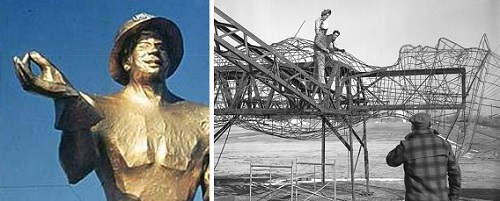
The original Golden Driller of 1953, left, proved so popular that a more permanent version (supported with steel rods) returned for the 1966 Petroleum Expo. Photos courtesy Tulsa Historical Society.
Now a Tulsa tourist attraction, the mustard-shaded driller, weighing 43,500 pounds, stands among the largest freestanding statues in the world, according to city officials. Promotional t-shirts, ties, and scarfs — and in 2020 a Covid-19 mask — have occasionally adorned the statue.
Learn more in Golden Driller of Tulsa.

May 14, 2004 – Museum Opens in Oil City, Louisiana
Louisiana’s first publicly funded museum dedicated to the petroleum industry opened in Oil City, about 20 miles north of Shreveport. The Louisiana State Oil and Gas Museum, originally called the Caddo-Pine Island Oil and Historical Museum, opened at a former depot of the Kansas City Southern Railroad.

The museum in Caddo Parish, Louisiana, includes outdoor exhibits of modern oil production technology.
The museum has since preserved the Caddo Parish oilfield discoveries, which began in 1905 and brought sustained economic prosperity to North Louisiana. Museum exhibits reveal the technologies behind a 1911 well drilled by Gulf Refining Company that was among the earliest “offshore” oil wells. The Ferry Lake No. 1, completed on Caddo Lake, produced 450 barrels of oil per day from a depth of 2,185 feet (see First Louisiana Oil Wells).
May 15, 1911 – Supreme Court mandates Break Up of Standard Oil
After reviewing 12,000 pages of court documents, the Supreme Court issued its majority opinion mandating dissolution of the Standard Oil Company of New Jersey into 34 separate companies. The Justice Department had filed an antitrust lawsuit against Standard Oil in 1909. The Supreme Court’s ruling upheld a circuit court decision that Standard Oil’s practices violated the Sherman Antitrust Act. The company was given six months to spin off its subsidiaries.

May 15, 1940 — Nylon Stockings Go on Sale
One year after being unveiled at the 1939 New York World’s Fair, nylon stockings went on sale for the first time at Gimbels Department Store in Manhattan. Promoted as “strong as steel, as fine as spiderweb,” first-year sales reached about 64 million pairs at $1.35 each for the DuPont Company petroleum product, according to ABC News.
“Women’s love affair with nylon stockings has had a long run,” the network proclaimed in 2010. Nylon had been used for toothbrush bristles for “Dr. West’s Miracle-Tuft” as early as February 1938 (see Nylon, a Petroleum Polymer).
May 16, 1817 – U.S. Geology Described and Mapped
Scottish American geologist William Maclure presented his detailed study of U.S. geology to the Academy of Natural Sciences of Philadelphia. He would be named president of the Academy, a post he would hold for 22 years, and become known as the “father of American Geology.”
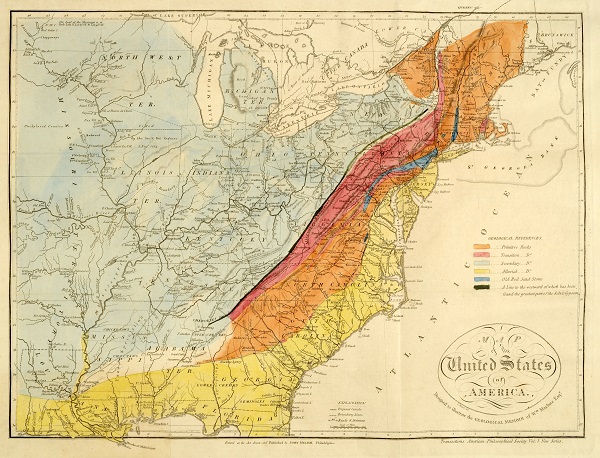
An 1818 map by William Maclure provided a more detailed version of a geological map he published in 1809. Image courtesy the Historic Maps Collection, Princeton Library.
The American Philosophical Society published Maclure’s detailed study in 1818 as “Observations on the Geology of the United States of North America.”
May 16, 1934 – National Stripper Well Association established
The National Stripper Well Association (NSWA) organized in Tulsa, Oklahoma, to represent operators of stripper wells — marginal wells that produce less than 15 barrels of oil a day or less than 90 thousand cubic feet of natural gas a day. In 2023, about 400,000 oil stripper wells accounted for more than 7.4 percent of U.S. oil production, according to NSWA. About 360,000 natural gas stripper wells accounted for 8.2 percent of gas production.

May 16, 1961 – Museum opens over Natural Gas Field
In southwestern Kansas, the Stevens County Gas & Historical Museum in Hugoton opened above a natural gas producing formation extending 8,500 square miles into the Oklahoma and Texas panhandles. The town’s museum has since educated visitors about one of the largest natural gas fields in North America — the Hugoton field. A gas well drilled in 1945 still produces on the museum grounds.
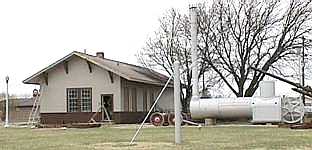
A small Stevens County natural gas museum in Hugoton, Kansas, preserves the history of a gas field that extends into two other states.
Although the Hugoton field’s once dominant natural gas production gave way to gas shale and coalbed methane regions, including production from Fayetteville, Arkansas, (2004) and Haynesville, Louisiana (2008), the Hugoton-Panhandle gas continues to be a leading source of helium.
Learn more in Hugoton Natural Gas Museum.
May 17, 1882 – Mystery Well Production revealed
The true oil production of a closely guarded discovery well in the Warren County, Pennsylvania, township was revealed to be 1,000 barrels of oil a day. News about Jamestown Oil Company’s “Mystery Well” sent shock waves through petroleum market centers.
“The excitement in the oil exchanges was indescribable,” noted Paul H. Giddens in his 1938 classic, The Birth of the Oil Industry. “Over 4,500,000 barrels of oil were sold in one day on the exchanges in Titusville, Oil City and Bradford.”

In 2007, Cherry Grove, Pennsylvania, oil patch volunteers rebuilt a derrick to celebrate their historic 1882 Mystery Well.
Although the Cherry Grove discovery demoralized the market and drove oil prices down to less than 50 cents per barrel, hundreds of derricks appeared around Cherry Grove and thousands of people moved there while the boom lasted. It was short lived, according to volunteers of Cherry Grove Old Home and Community Day Committee, which has kept the “Oil Excitement” alive with special events.
Learn more in Cherry Grove Mystery Well.
May 17, 1901 – Gulf Oil begins at Spindletop Hill
James M. Guffey organized Guffey Petroleum Company to buy the famous “Lucas Gusher” well drilled the previous January at Spindletop Hill near Beaumont, Texas. Guffey purchased about half of the well’s high-volume oil production (the Mellon family of Pittsburgh owned the remainder). Guffey created Gulf Refining Company to refine and market the oil produced by Guffey Petroleum. In 1907, Andrew Mellon acquired J.M. Guffey Petroleum and Gulf Refining companies of Texas and reorganized them as Gulf Oil.

May 17, 1973 – Last Nuclear fracturing of Natural Gas Well
Atomic Energy Commission scientists conducted the last experiment of the Plowshare Program with a nearly simultaneous detonation of three 33-kiloton devices in a Colorado natural gas well. Project Rio Blanco was the third and final underground detonation to test nuclear fracturing of gas wells.
The first had been Project Gasbuggy in 1967, when a 29-kiloton nuclear device fractured a New Mexico well. A second experiment, Project Rulison, detonated a 40-kiloton device in a Colorado well in 1969. All three projects improved production, but the natural gas proved too radioactive.
May 19, 1885 – Lima Oilfield discovered in Ohio
Ohio’s petroleum industry began when Benjamin Faurot found oil at Lima in the northwestern part of the state. He had been searching for natural gas in the prolific Trenton Rock Limestone (see Indiana Natural Gas Boom). “If the well turns out, as it looks now that it will, look out for the biggest boom Lima ever had,” proclaimed Lima’s Daily Republican newspaper.
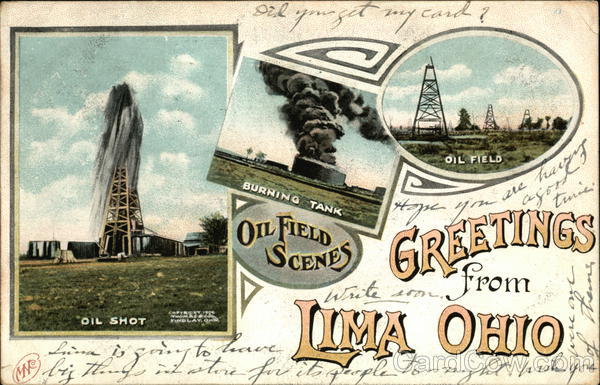
A postcard promotes the oil wealth of Lima, Ohio, and the giant oilfield discovered there in 1885. Circa 1909 postcard published by Robbins Bros., Boston.
Faurot organized the Trenton Rock Oil Company, and by 1886 the Lima oilfield was producing more than 20 million barrels of oil, the most in the nation. The Lima field’s heavy oil needed special refining, and Standard Oil Company of New Jersey in 1889 began construction on the Whiting refinery.
Learn more in Great Oil Boom of Lima, Ohio.
May 19, 1942 – Oklahoma Inventor patents Portable Drilling Rig
A pioneer in oilfield technologies, George E. Failing of Enid, Oklahoma, received a patent for his design of a drilling rig on a truck bed. “I designate the rear portion of a drilling rig such as used in drilling shallow wells, the taking of cores, drilling of shot-holes, and performing similar oil field operations,” Failing noted in his patent.
In 1931, he had mounted a rig on a 1927 Ford farm truck, “adding a power take-off assembly to transfer power from the truck engine to the drill,” according to the Oklahoma Historical Society. Failing would receive more than 300 patents for oilfield tools, “from rock bit cores to an apparatus for seismic surveying.”
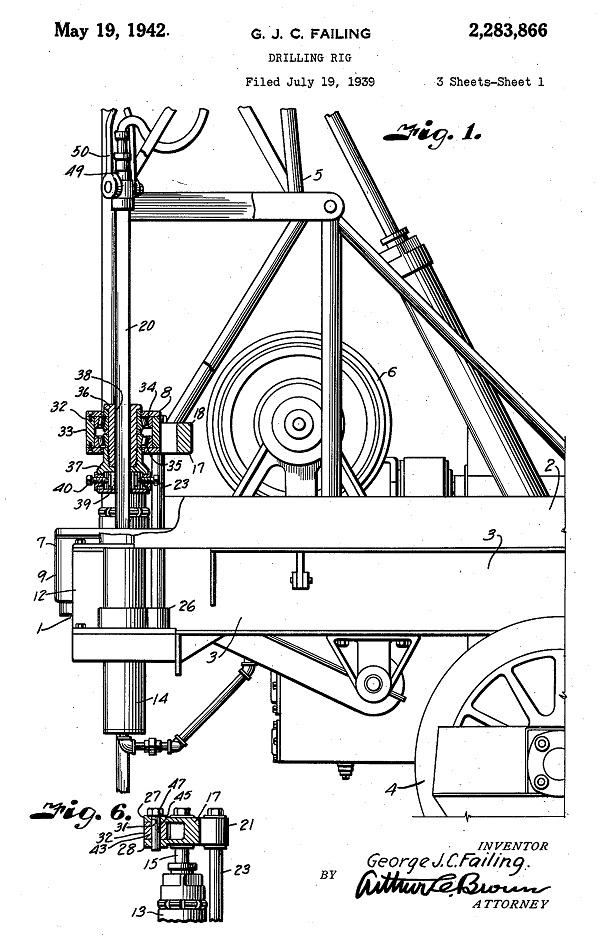
George Failing’s drilling rig — powered by its truck’s engine — will prove ideal for slanted wells.
Failing’s portable rig could drill ten slanted, 50-foot holes in a single day, while a traditional rotary rig took about a week to set up and drill to a similar depth. He demonstrated his portable drilling technology at a 1933 well disaster in Conroe, Texas, working with H. John Eastman, today considered the father of directional drilling (see Technology and the “Conroe Crater”).
_______________________
Recommended Reading: Louisiana’s Oil Heritage, Images of America (2012); Oil in Oklahoma
(2012); Oil in Oklahoma (1976); Titan: The Life of John D. Rockefeller, Sr.
(1976); Titan: The Life of John D. Rockefeller, Sr. (2004); The Extraction State, A History of Natural Gas in America (2021); Cherry Run Valley: Plumer, Pithole, and Oil City, Pennsylvania
(2004); The Extraction State, A History of Natural Gas in America (2021); Cherry Run Valley: Plumer, Pithole, and Oil City, Pennsylvania (2000); Trek of the Oil Finders: A History of Exploration for Petroleum (1975); The Birth of the Oil Industry (1938); Ohio Oil and Gas, Images of America
(2000); Trek of the Oil Finders: A History of Exploration for Petroleum (1975); The Birth of the Oil Industry (1938); Ohio Oil and Gas, Images of America (2008); History Of Oil Well Drilling
(2008); History Of Oil Well Drilling (2007); Drilling Technology in Nontechnical Language
(2007); Drilling Technology in Nontechnical Language (2012). Your Amazon purchase benefits the American Oil & Gas Historical Society. As an Amazon Associate, AOGHS earns a commission from qualifying purchases.
(2012). Your Amazon purchase benefits the American Oil & Gas Historical Society. As an Amazon Associate, AOGHS earns a commission from qualifying purchases.
_______________________
The American Oil & Gas Historical Society (AOGHS) preserves U.S. petroleum history. Become an AOGHS annual supporting member and help maintain this energy education website and expand historical research. For more information, contact bawells@aoghs.org. Copyright © 2024 Bruce A. Wells. All rights reserved.
by Bruce Wells | Jan 3, 2024 | Petroleum Art
Dr. Seuss created zoological oddities for Esso products of Standard Oil Company of New Jersey.
Seuss the oilman? Thirty years before the Grinch stole Christmas in 1957, many strange and wonderful critters of the popular children’s book author could be seen in Standard Oil Company advertising campaigns.
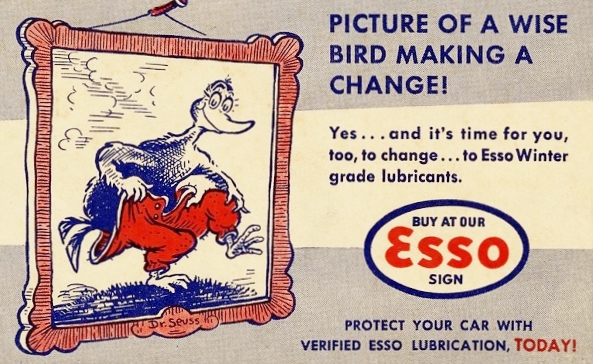
Between 1930 and 1940, Theodor Seuss Geisel created distinctive characters for Standard Oil advertising campaigns, including this “wise bird” for Essolube oil change cards. Illustration courtesy University of California San Diego Library.
During the Great Depression, fanciful creatures drawn by the future Dr. Seuss promoted Essolube and other products for Standard Oil of New Jersey. He later said his experience at Standard, “taught me conciseness and how to marry pictures with words.”

A 1927 cartoon by Theodor Seuss Geisel featured Standard Oil’s petroleum product “Flit,” a popular bug spray.
In the cartoon that launched his career, Theodor Seuss Geisel drew a peculiar dragon inside a castle. The January 14, 1928, issue of New York City’s Judge magazine featured the beast. Geisel would soon introduce America to many less threatening characters inhabiting his imaginative menagerie.
“Flit,” was a popular bug spray of the day — especially against flies and mosquitoes. It was one of many Standard Oil Company of New Jersey consumer products derived from oil and natural gas (also see petroleum products).

Late in 1927, Standard Oil’s growing advertising department, which had focused on sales of Standard and Esso gasoline, lubricating oil, fuel oil and asphalt, reorganized to promote other products, according to author Alfred Chandler Jr.

Dr. Seuss later said his experience working at Standard Oil helped him develop his fantastical characters and tales.
“Specialties, such as Nujol, Flit, Mistol, and other petroleum by-products that could not be effectively sold through the department’s sales organization were combined in a separate subsidiary — Stanco,” noted Chandler in his book, Strategy and Structure: Chapters in the History of the American Industrial Enterprise.
Chandler’s 1962 book also examined General Motors Company, Sears, Roebuck and Company, and gunpowder manufacturer E.I. du Pont de Nemours.
“Quick, Henry, the Flit!”
Geisel’s fortuitous bug-spray cartoon depicted a medieval knight in his bed, facing a dragon who had invaded his room, and lamenting, “Darn it all, another dragon. And just after I’d sprayed the whole castle with Flit.”

According to nn anecdote in Judith and Neil Morgan’s 1995 book Dr. Seuss and Mrs. Geisel, the wife of the advertising executive who handled the Standard Oil account was impressed by the cartoon.

Circa 1935 ad for a Standard Oil petroleum product was characteristic of the imagination that would make Ted Geisel the definitive children’s book author. Illustration courtesy University of California San Diego Library.
“At her urging, her husband hired the artist, thereby inaugurating a 17-year campaign of ads whose recurring plea, ‘Quick, Henry, the Flit!,’ became a common catchphrase,” noted a curator of the Dr. Seuss Collection at the University of California, San Diego.
“These ads, along with those for several other companies, supported the Geisels throughout the Great Depression and the nascent period of his writing career,” the curator added.
Besides promoting the Standard Oil companies Flit and Esso, Dr. Seuss’ creations helped sell such diverse goods as ball bearings, radio programs, beer brands, and sugar, notes the library, located in La Jolla, where Geisel was a longtime resident.
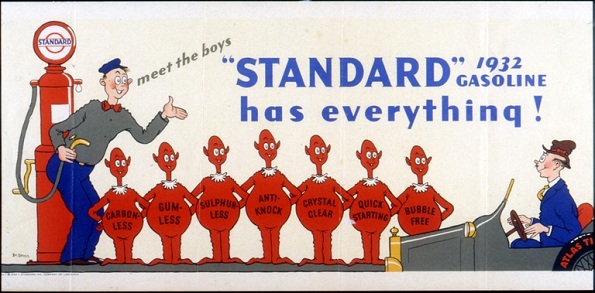
This 1932 Standard Oil Company (New Jersey) advertisement is among those preserved by the Dr. Seuss Collection of the Mandeville Special Collections Library at the University of California, San Diego.
At the University of California, San Diego, the Dr. Seuss Collection in the Mandeville Special Collections Library contains original drawings, sketches, proofs, notebooks, manuscript drafts, books, audio and videotapes, photographs, and memorabilia.

More than 8,500 items document and preserve Dr. Seuss’ creative achievements, beginning in 1919 with his high school activities and ending with his death in 1991.
Karbo-nockus and Other Critters
The future Dr. Seuss added a host of zoological oddities to Standard Oil’s lexicon while promoting Esso products (Esso was an acronym for Eastern States Standard Oil). His critters promoted Essomarine oil and greases as well as Essolube Five-Star Motor Oil.
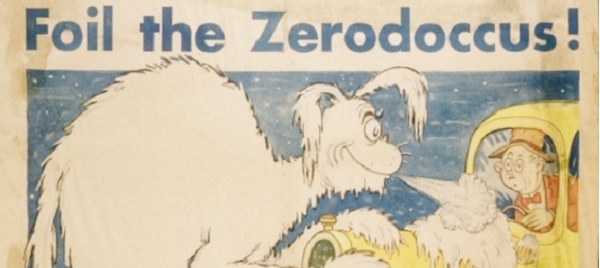
Standard Oil advertising campaigns provided a steady income to Geisel and his wife throughout his early days experimenting with his drawings.
Smiling, toothy creatures such as Zero-doccus, Karbo-nockus, Moto-raspus and Oilio-Gobelus appeared in advertisements that warned motorists of the hazards of driving without the protection of Standard Oil lubrication.

Motor oil cartoon ad drawn by the future children’s book author Dr. Seuss. First sold in the 1930s, Essolube has remained a popular product, today for ExxonMobil.
“Meet the Zero-doccus. He is the first if a group of terrible beasts that are being turned loose in the advertising of Essolube, Standard Oil Company (New Jersey) products,” reported the December 8, 1932, Printers’ Insider, an advertising trade journal.
Other Esso “moto-monsters” would be introduced in newspapers and outdoor posters in coming months, the trade journal proclaimed.
“These creatures symbolize and dramatize some of the troubles of motorists who use inferior oils. The Zero-doccus pounces on cold motors and makes quick starting difficult with ordinary oils,” the article noted. “He and his coming friends are the creations of Dr. Seuss of ‘Quick, Henry, the Flit’ fame.”
The Printers’ Insider article predicted the strange Esso creatures would prove popular when they appeared in ads nationwide.
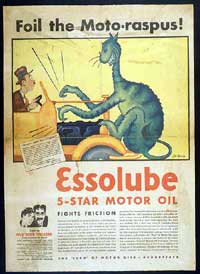
A dependable income from Standard Oil during the Great Depression helped Dr. Seuss publish his first children’s book in 1936.
Seuss in Esso Navy
Throughout his early hard years, these Standard Oil advertising campaigns provided steady income to Geisel and his wife. “It wasn’t the greatest pay, but it covered my overhead so I could experiment with my drawings,” he later said.
Geisel noted his advertising work allowed him to experiment creating subtle visual messages while using wacky rhymes in story telling.

In 1936, Geisel designed Standard Oil’s Essomarine booth for the National Motorboat Show — and created the phenomenally successful “Seuss Navy.” Young and old visitors were commissioned as admirals and photographed with whimsical characters made of cardboard.

Standard Oil Company marketers promoted Essomarine products during the 1940 National Motor Boat Show in New York City.
By 1940, the Seuss Navy included more than 2,000 enthusiastic admirals (with such notables as bandleader Guy Lombardo). Geisel remembered that, “It was cheaper to give a party for a few thousand people, furnishing all the booze, than it was to advertise in full-page ads.”
As Dr. Seuss, Geisel wrote and illustrated his first children’s book, And to Think That I Saw It on Mulberry Street, published on December 21, 1937, by Vanguard Press after being rejected by 27 other publishers.
Twenty years later, The Cat in the Hat was inspired by a 1954 Life Magazine essay critical of children’s literacy and the stilted “See Spot Run” style of reading primers. Published in 1957, The Cat in the Hat used just 236 words — and only 14 of them with two syllables. It remains his most popular work.
The former Standard Oil advertising illustrator wrote more than 50 children’s books over a half-century career that brought the world Hop on Pop, Green Eggs and Ham and many others. Children lost a friend on September 24, 1991, when Theodor Seuss Geisel died at the age of 87.
View online the Dr. Seuss Collection: Advertising Artwork of Dr. Seuss, preserved by Mandeville Special Collections Library, University of California.
Kerosene in Art
At the beginning of the 20th century, French illustrator Jules Chéret (1836-1933) was famous for his lithograph posters for theatres, music halls, beverages, and medicines. During a long career, many of his commercial posters promoted a French petroleum company’s lamp oil.

Chéret, who would be called “the father of the modern lithograph” and “king of the poster,” produced popular posters for “Saxoleinem,” the company’s refined “pétole de sureté”– safety lamp oil.

French advertisement for “The Halo of the South,” a safety oil for lamps, in an 1895-1900 lithograph by artist Jules Chéret.
“He was often imitated, and an entire generation of artists would follow and build on his work. One of them was Henri de Toulouse-Lautrec,” notes Chicago’s Richard H. Driehaus Museum. “To acknowledge his debt to the older artist, Lautrec sent Chéret a copy of every poster he produced.”
Learn about more examples of artists and the petroleum industry in Oil in Art.
_______________________
Recommended Reading: Theodor Geisel: A Portrait of the Man Who Became Dr. Seuss (2010); The History of the Standard Oil Company: All Volumes
(2010); The History of the Standard Oil Company: All Volumes  (2015); Strategy and Structure: Chapters in the History of the American Industrial Enterprise (1962); Dr. Seuss & Mr. Geisel: A Biography (1995). Your Amazon purchase benefits the American Oil & Gas Historical Society. As an Amazon Associate, AOGHS earns a commission from qualifying purchases.
(2015); Strategy and Structure: Chapters in the History of the American Industrial Enterprise (1962); Dr. Seuss & Mr. Geisel: A Biography (1995). Your Amazon purchase benefits the American Oil & Gas Historical Society. As an Amazon Associate, AOGHS earns a commission from qualifying purchases.
_______________________
The American Oil & Gas Historical Society (AOGHS) preserves U.S. petroleum history. Become an AOGHS annual supporting member and help maintain this energy education website and expand historical research. For more information, contact bawells@aoghs.org. Copyright © 2024 Bruce A. Wells. All rights reserved.
Citation Information – Article Title: “Seuss I am, an Oilman.” Authors: B.A. Wells and K.L. Wells. Website Name: American Oil & Gas Historical Society. URL: https://aoghs.org/petroleum-art/seuss-the-oilman. Last Updated: January 4, 2024. Original Published Date: December 1, 2008.
by Bruce Wells | Nov 20, 2023 | This Week in Petroleum History
November 20, 1866 – Improved Well Torpedo patented –
Col. Edward A.L. Roberts of New York City patented improvements to his Roberts Torpedo, an oilfield technology for increasing production by fracturing oil-bearing formations.
“Our attention has been called to a series of experiments that have been made in the wells of various localities by Col. Roberts, with his newly patented torpedo,” noted the Titusville Morning Herald newspaper in 1865. “The results have in many cases been astonishing.”

Portrait of Edward Roberts, a Civil War veteran who patented well “torpedo” technologies that improved oilfield production.
The Civil War Union Army veteran would receive many patents for his “Exploding Torpedoes in Artesian Wells” method to increase petroleum production (see Shooters – A “Fracking” History).
November 20, 1930 – Oil Booms help Hilton expand in Texas
After buying his first hotel in the booming oil town of Cisco, Texas, Conrad Hilton opened a high-rise in El Paso. While visiting Cisco in 1919, Hilton had witnessed roughnecks from the Ranger oilfield waiting for rooms. Hilton’s first hotel, the Mobley, offered 40 rooms for eight-hour periods to coincide with workers’ shifts.
Thanks to booming oilfields, Hilton was firmly established in the Texas hotel business. His El Paso Hilton (now the Plaza Hotel) was placed on the National Register of Historic Places in 1980.

November 20, 1980 – Texaco Well drains Louisiana Lake
Minutes after its drilling crew evacuated, a Texaco drilling platform overturned and disappeared into a whirlpool that drained Lake Peigneur, Louisiana, over the next three hours. The crew had accidently penetrated a salt dome containing the mining operations of Diamond Crystal Salt Company.
All 50 miners working as deep as 1,500 feet below the surface escaped with no serious injuries as a maelstrom swallowed the $5 million Texaco platform — and 11 barges holding drilling supplies.
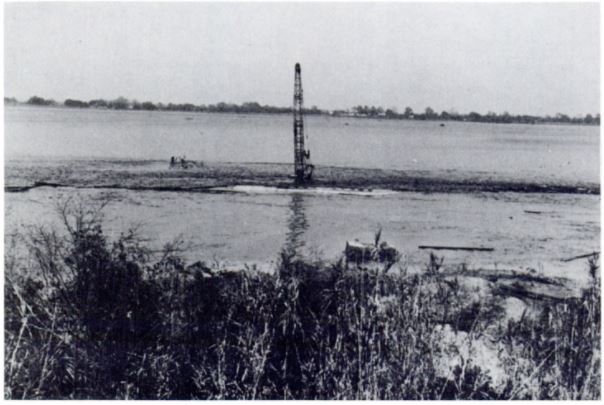
Photo from a 1981 government report on Texaco’s accidental “Jefferson Island Mine Inundation” of one year earlier.
“Texaco, who had ordered the oil probe, was aware of the salt mine’s presence and had planned accordingly; but somewhere a miscalculation had been made, which placed the drill site directly above one of the salt mine’s 80-foot-high, 50-foot-wide upper shafts,” noted a 2005 article.
According to a 1981 government report, “Jefferson Island Mine Inundation,“ evidence for identifying the exact cause was washed away, but Texaco and Wilson Drilling paid $32 million to Diamond Crystal Salt Company and another $12.8 million to a nearby botanical garden. Changed from freshwater to saltwater with a depth reaching 200 feet, Lake Peigneur became the deepest lake in Louisiana.
November 21, 1925 – Magnolia Petroleum incorporates –
Formerly an unincorporated joint-stock association with roots dating to an 1889 refinery in Corsicana, Texas, Magnolia Petroleum Company incorporated. The original association had sold many grades of refined petroleum products through more than 500 service stations in Texas, Oklahoma, and Arkansas.
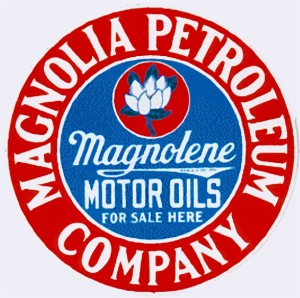
Magnolia Petroleum operated gas stations throughout the Southeast.
Within a month of the new company’s founding, John D. Rockefeller’s Standard Oil of New York (Socony) purchased most Magnolia Petroleum assets and operated it as a subsidiary. Magnolia merged with the Socony Mobile Oil Company in 1959 and adopted the red Pegasus logo, replacing the magnolia logo at gas stations (see Mobil’s High-Flying Trademark). Magnolia Petroleum assets were part of 1999 merger that created today’s ExxonMobil.

November 21, 1980 – Millions watch “Dallas” Episode Who shot J.R
The cliffhanger episode “Who shot J.R.?” on the prime-time soap opera “Dallas” was watched by 83 million people in the United States and 350 million worldwide, according to History.com. The CBS show, which debuted in 1978, revolved around two Texas oil families and featured Larry Hagman as J.R. Ewing, “the character fans loved to hate.” His portrayal of a “greedy, conniving, womanizing scoundrel” and the business dealings of Ewing Oil Company would stereotype the Texas petroleum industry for 14 seasons.
November 22, 1878 – Tidewater Pipe Company established
Byron Benson organized the Tidewater Pipe Company in Pennsylvania. In 1879 his company would build the first oil pipeline to cross the Alleghenies from Coryville to the Philadelphia Reading Railroad 109 miles away in Williamsport. This technological achievement was considered by many as the first true oil pipeline in America, if not the world.
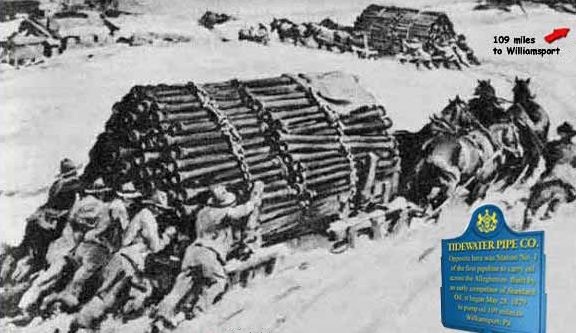
Despite protests from teamsters, a 109-mile oil pipeline revolutionized oil transportation. Photo courtesy explorepahistory.com.
The difficult work — much of it done in winter using sleds to move pipe sections — bypassed Standard Oil Company’s dominance in transporting petroleum. Tidewater made an arrangement with Reading Railroad to haul the oil in tank cars to Philadelphia and New York. In 1879, about 250 barrels of oil from the Bradford field was pumped across the mountains and into Williamsport.
More than 80 percent of America’s oil soon would come from Pennsylvania oilfields, according to Floyd Hartman Jr. in a 2009 article, “Birth of Coryville’s Tidewater Pipe Line.”

November 22, 1905 – Glenn Pool Field discovered in Indian Territory
Two years before Oklahoma statehood, the Glenn Pool (or Glenpool) oilfield was discovered in the Creek Indian Reservation south of Tulsa. The greatest oilfield in America at the time, it would help make Tulsa the “Oil Capital of the World.” Many independent oil producers, including Harry Sinclair and J. Paul Getty, got their start during the Glenn Pool boom.
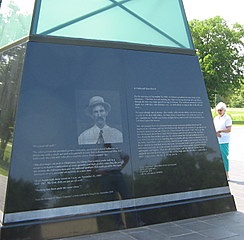
An oilfield pioneers monument was dedicated in April 2008 at Glenpool, Oklahoma. Photo by Bruce Wells.
With production exceeding 120,000 barrels of oil a day, Glenn Pool exceeded Tulsa County’s earlier Red Fork Gusher. The giant oilfield even exceeded production from Spindletop Hill in Texas four years earlier. The Ida Glenn No. 1 well, drilled to about 1,500 feet deep, led to more prolific wells in the 12-square-mile Glenn Pool.
By the time of statehood in 1907, Tulsa area oilfields made Oklahoma the biggest U.S. oil producing state. Advances in enhanced recovery technologies later added to the region’s productivity. Glenpool residents celebrate their “Black Gold Days,” and the 46th annual festival took place September 26-29, 2023, in Black Gold Park.
Learn more in Making Tulsa “Oil Capital of the World.”
November 22, 2003 – Smithsonian Museum opens Transportation Hall
A permanent exhibit about U.S. transportation history opened at the Smithsonian’s National Museum of American History in Washington, D.C. “Get your kicks on 40 feet of Route 66,” the Smithsonian exhibit noted on opening day of the $22 million renovation of the museum’s Hall of Transportation.
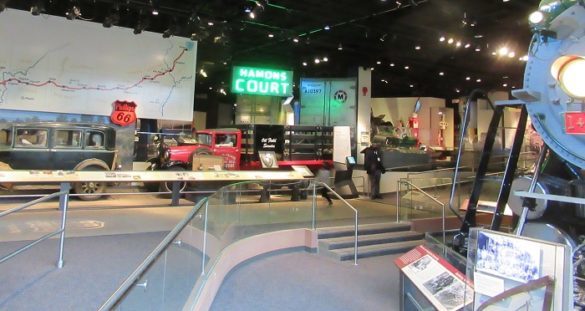
Opened in 2003 after a $22 million renovation, the Transportation Hall of the National Museum of American History exhibits 340 historic objects in 26,000 square feet. Photo by Bruce Wells.
The hall was designed to let visitors “travel back in time and experience transportation as it changed America.” Opening day exhibits included 340 objects and 19 historic settings in chronological order. At the same museum in 1967, the Smithsonian’s “Hall of Petroleum” devoted an entire wing to drilling rigs, pipelines, and pump jacks.
Learn more in America on the Move.
November 23, 1951 – Superman and the World’s Deepest Oil Well
Public fear of the risk of drilling wells too deep highlighted the theatrical release of Superman’s first feature length movie, “Superman and the Mole Men.” The 1951 plot unfolded in the fictional town of Silsbey, “Home of the World’s Deepest Oil Well,” after an experimental well’s drill bit had “broken into clear air” at a depth of 32,742 feet.
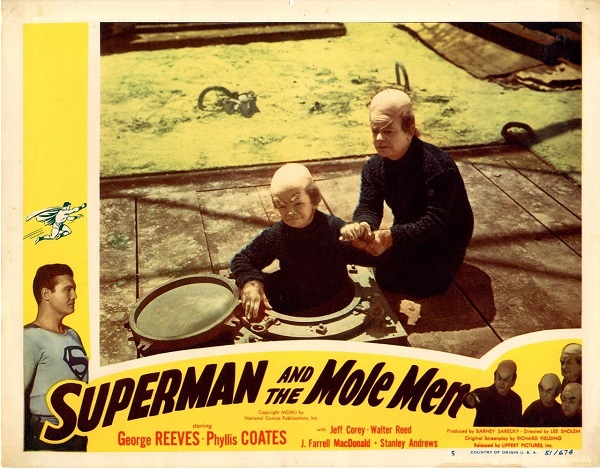
Mole men emerge from an experimental oil well drilled more than six miles deep.
“Good heavens, that’s practically to the center of the earth!” exclaimed Lois Lane (in fact, the deepest U.S. well in 1951 reached 20,521 feet). When mole-men emerged from the well, townspeople feared an invasion. In the end, Superman calmed an angry mob and the well ignited in flames, forever closing the connection between the two worlds.
Learn about a real six-mile-deep well in Anadarko Basin in Depth.

November 23, 1947 – World’s First LPG Ship
The first U.S. seagoing Liquefied Petroleum Gas (LPG) ship went into service as Warren Petroleum Corporation of Tulsa, Oklahoma, sent the Natalie O. Warren from the Houston Ship Channel to Newark, New Jersey. The vessel had an LPG capacity of 38,053 barrels in 68 vertical pressure tanks.

The first vessel had an LPG capacity of 38,053 barrels in 68 vertical pressure tanks.
The one-of-a-kind ship was the former Cape Diamond dry-cargo freighter, converted by the Bethlehem Steelyard in Beaumont, Texas. The experimental design would lead to new maritime construction standards for such vessels. Warren Petroleum was the largest producer and marketer of natural gasoline and propane in the world by the early 1950s, according to an exhibit at the Tulsa Historical Society and Museum. LPG tankers today carry 20 times the capacity of the early vessels.
November 25, 1875 – Continental Oil brings Kerosene to the West
Convinced that he could profit by purchasing bulk kerosene in cheaper eastern markets, Isaac Blake formed the Continental Oil and Transportation Company. He soon transported Ohio kerosene to Ogden, Utah, for distribution.
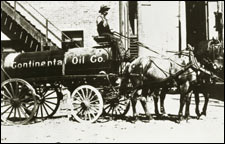
Conoco began in 1875 as Continental Oil, delivering kerosene to retail stores in Ogden, Utah.
Continental purchased two railroad tank cars — the first to be used west of the Mississippi River — and began shipping kerosene from a Cleveland refinery. The company grew, expanding into Colorado in 1876 and California in 1877. Standard Oil Company absorbed Continental Oil in 1885.
Following the 1911 breakup of Standard, Continental Oil reemerged as Conoco, becoming ConocoPhillips in 2002 (see ConocoPhillips Petroleum Museums).
_______________________
Recommended Reading: History Of Oil Well Drilling (2007); Be My Guest
(2007); Be My Guest (1957); Magnolia Oil News Magazine
(1957); Magnolia Oil News Magazine (January 1930); Oil and Gas Pipeline Fundamentals
(January 1930); Oil and Gas Pipeline Fundamentals (1993); Glenn Pool…and a little oil town of yesteryear
(1993); Glenn Pool…and a little oil town of yesteryear (1978); The American Highway: The History and Culture of Roads in the United States
(1978); The American Highway: The History and Culture of Roads in the United States (2000); CONOCO: The First One Hundred Years Building on the Past for the Future
(2000); CONOCO: The First One Hundred Years Building on the Past for the Future (1975). Your Amazon purchase benefits the American Oil & Gas Historical Society. As an Amazon Associate, AOGHS earns a commission from qualifying purchases.
(1975). Your Amazon purchase benefits the American Oil & Gas Historical Society. As an Amazon Associate, AOGHS earns a commission from qualifying purchases.
_______________________
he American Oil & Gas Historical Society (AOGHS) preserves U.S. petroleum history. Become an AOGHS annual supporting member and help maintain this energy education website and expand historical research. For more information, contact bawells@aoghs.org. Copyright © 2023 Bruce A. Wells. All rights reserved.







(2012); Oil in Oklahoma
(1976); Titan: The Life of John D. Rockefeller, Sr.
(2004); The Extraction State, A History of Natural Gas in America (2021); Cherry Run Valley: Plumer, Pithole, and Oil City, Pennsylvania
(2000); Trek of the Oil Finders: A History of Exploration for Petroleum (1975); The Birth of the Oil Industry (1938); Ohio Oil and Gas, Images of America
(2008); History Of Oil Well Drilling
(2007); Drilling Technology in Nontechnical Language
(2012). Your Amazon purchase benefits the American Oil & Gas Historical Society. As an Amazon Associate, AOGHS earns a commission from qualifying purchases.





















